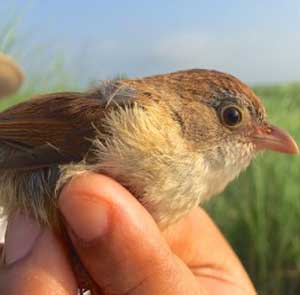Jerdon’s babbler (Chrysomma altirostre) had not been seen in Myanmar since July 1941, where it was last found in grasslands near the town of Myitkyo, Bago Region near the Sittaung River.
The rediscovery was described in the recently published issue of Birding Asia, the magazine of the Oriental Bird Club.
The team found the bird on 30 May 2014 while surveying a site around an abandoned agricultural station that still contained some grassland habitat. After hearing the bird’s distinct call, the scientists played back a recording and were rewarded with the sighting of an adult Jerdon’s babbler. Over the next 48 hours, the team repeatedly found Jerdon’s babblers at several locations in the immediate vicinity and managed to obtain blood samples and high-quality photographs.
The small brown bird, about the size of a house sparrow, was initially described by British naturalist TC Jerdon in January 1862, who found it in grassy plains near Thayetmyo.
At the beginning of the 20th century, the species was common in the vast natural grassland that once covered the Ayeyarwady and Sittaung flood plains around Yangon. Since then, agriculture and communities have gradually replaced most of these grasslands as the area has developed.
Said, Colin Poole, Director of WCS’s Regional Conservation Hub in Singapore, “The degradation of these vast grasslands had led many to consider this subspecies of Jerdon’s Babbler extinct. This discovery not only proves that the species still exists in Myanmar but that the habitat can still be found as well. Future work is needed to identify remaining pockets of natural grassland and develop systems for local communities to conserve and benefit from them.”
The Jerdon’s Babbler in Myanmar is currently considered as one of three subspecies found in the Indus, Bhramaputra, and Ayeyarwady River basins in South Asia. All show subtle differences and may yet prove to be distinctive species.
Further analysis of DNA samples taken from the bird will be studied at the Department of Biological Sciences at the NUS Faculty of Science, to determine if Jerdon’s babbler in Myanmar should be considered a full species. If so, the species would be exclusive to Myanmar and be of very high conservation concern because of its fragmented and threatened habitat.
Explained Assistant Professor Frank Rheindt of the Department, who was a key member of the field team and leader of the genetic analysis, “Our sound recordings indicate that there may be pronounced bioacoustic differences between the Myanmar subspecies and those further west, and genetic data may well confirm the distinctness of the Myanmar population.”

















Related Items
Noise and din in Braj, Ancient temple music become extinct...
Study Demonstrates Bird Migration Seasonality In Response To Environmental Cues
76-million-year-old Extinct Species Of Pig-snouted Turtle Unearthed